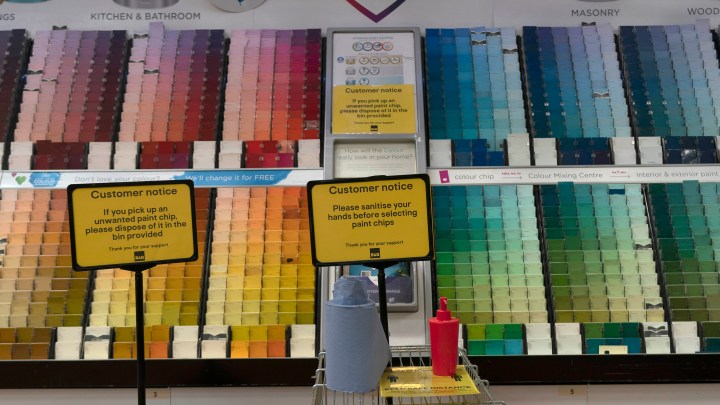
Here’s another shortage to add to the list: paint
Here’s another shortage to add to the list: paint

A mix of factors, from an unusual freeze in Texas to ongoing supply chain issues with raw materials like resin, have resulted in a paint shortage. Sherwin Williams CEO John G. Morikis even told investors that “the persistent and industry-wide raw material availability constraints and pricing inflation we have previously reported have worsened, and we do not expect to see improved supply or lower raw material pricing in our fourth quarter as anticipated.”
“Marketplace” host Kai Ryssdal spoke with business owner Ryan Amato of Ryan Amato Painting in Easton, Pennsylvania, to talk about how his business has been weathering the shortages. The following is an edited transcript of their conversation.
Kai Ryssdal: Paint shortages, really?
Ryan Amato: Well, we’ve been hearing about it for well over a year, and then the pandemic hit, so that was an issue. There’s been, obviously, a labor shortage so the truck drivers delivering the paint, that’s been an issue. There was the freeze down in Texas, and they supply a good amount of the resins, which is an ingredient for all the paints that we use.
Ryssdal: Yes, it’s a chemicals-heavy process, right?
Amato: Absolutely. It’s an ingredient. Just like you bake a cake, it’s one of our main ingredients in the paint, and we’ve had a major shortage of it.
Ryssdal: So what are you doing?
Amato: Well, I like to think that we’re well prepared at my company. So, we have great suppliers and vendors. Unfortunately, if you came to our shop, I’m looking at about 500 gallons of untinted paint sitting on pallets; just so we’re prepared for our customers, we’re ordering in very large quantities of paint.
Ryssdal: The catch, of course, is that untinted paint is no good if I need to paint my house blue, right?
Amato: Absolutely, yeah. And there are so many different bases of paint, so if you need a dark blue it’s a different base than white, so we just we’re trying to do the best we can to stay prepared for you, for the customer.
Ryssdal: Alright, so let’s make it about me. I do, in point of fact, actually need to have my house painted. How much of a lead time do I need to give you before you can say, “Yep, I’ll be there on Thursday.”?
Amato: That’s a great question, and it’s been a struggle. Historically, in our business, when we win a job, your job, we send you over a color sheet that you have to fill out. Normally not a big deal, give it to us a week or two before the project starts, and that’s typically in between four and six weeks. Now, we’re really twisting your arm behind your back; we need that color sheet a day or two, after your job is accepted. So we need about two or three weeks to make sure that we have the proper materials for your project.
Ryssdal: And I imagine, Mr. Amato, it’s going to cost me more, too, right?
Amato: It’s certainly going to cost you more. We’ve seen it’s been about 20% since really only about four or five months ago, and [a] 40% increase in our epoxy floors, which is pretty significant.
Ryssdal: I imagine you’ve got to go to your supplier, right? But is this one of those where you could find another source, and try to do it that way? I’m sure you thought of that.
Amato: And that’s what we’ve been doing. The only problem with that is — there’s many different suppliers and we all know them — paint is not all the same; you can’t just grab one gallon of paint and go to another vendor and grab another gallon of paint and it performs the same way. So not only are we seeing issues with paints we haven’t used before. It has also slowed down our production, our labor, because they’re using new paints. It requires different paintbrushes. They all perform differently. It’s been been a learning curve all around, not even to mention just the shortage of materials.
Ryssdal: That’s kind of wild that paint is not paint is not paint. It’s all different.
Amato: Absolutely.
Ryssdal: How long you’ve been in the painting business, Mr. Amato?
Amato: I’ve been in the painting business 30 years. I hate to say that. I feel like I’m getting older.
Ryssdal: Tell me, you ever seen anything like this?
Amato: No, never. The only other issue we had was … it’s always been labor. You know, we had some issues after 9/11 with labor and the amount of jobs. This has been very difficult.
There’s a lot happening in the world. Through it all, Marketplace is here for you.
You rely on Marketplace to break down the world’s events and tell you how it affects you in a fact-based, approachable way. We rely on your financial support to keep making that possible.
Your donation today powers the independent journalism that you rely on. For just $5/month, you can help sustain Marketplace so we can keep reporting on the things that matter to you.












